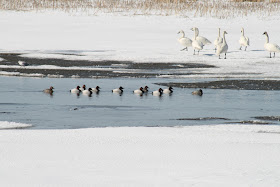The first time I ever saw a Sharp-shinned Hawk, I was sitting at my kitchen window watching the birds at my backyard feeders. All the sudden a dark streak swooshed across the yard and into a bush, a moment later it came out with one of my backyard patrons in it's talons and lit in one of my large trees and began to devour it.
Considered by some the scourge of backyard feeders the Sharp-shinned Hawk is not always a welcome guest. I cannot count the times people have called me, e-mailed me or just come up and ask; "how can I get rid of the hawk in my yard that keeps killing my little birds"? My answer, and I warn them that they will not like it is to "either take down their bird feeders, or you can leave them up and be happy that you have a balance in your yard". Most of the people roll their eyes and admit, "yes I know they need to eat too, I just wish they would leave my little birds alone". I had one lady that was so upset that a hawk was killing her little doves and quail that she wanted the hawks eradicated. Quail and Doves are two birds that have flourished in my neighborhood in the last few years, especially the Eurasian Collared Doves that were not even present in our area 5 years ago. These are hardly threatened species.
I got a lot of people upset a few years ago on an e-mail list serve that I used to participate in when someone asked that question. I stayed back and watched as different people responded with such solutions as "shoot it with a BB gun, or use a toy bow and arrow, these two options will sting but won't kill the bird and may discourage it from coming back". Yet another suggested "each time you see one in your yard go out with a big spoon and a pan and bang on it to drive it off". After watching these responses for a while and disturbed that people were suggesting violent solutions, I responded with my usual response, "if you don't want the hawks in your yard take down your feeders, but none of you should ever consider doing anything that would harm a bird of prey". I went on to tell them that a group of boys brought an unfortunate Sharpy to me one day and said it could not fly and wanted me to help it. I took it and looked it over and sure enough under one of it's wings there was a small hole in it's side, undoubtedly shot by a BB or pellet gun. I put the bird in a box and went in the house to call a wildlife rehabilitator. I went back out about 15 minutes later and the bird had died. BBs can kill a small hawk like a Sharp-shinned.
I told them that shooting a hawk with a BB gun is not harmless and that this bird died as a result of a BB, shot probably by someone feeding birds that wanted to get rid of the hawk. I kind of got on a soapbox and I said a few more things that probably did more harm than good because I offended many of the participants on the list serve who shot back at me with angry responses. By the way it was not a birding group list serve.
While the presence of a Sharp-shinned Hawk will quiet things down at my feeders I am always excited to see one. I would venture to guess that the majority of birds they consume in my neighborhood are House Sparrows, again hardly a threatened species.
 |
| This Sharp-shinned Hawk is a regular and welcomed visitor to my back yard |
Adult Description
- Small hawk.
- Tail long, barred, and ends with a square tip.
- Wings short and rounded.
- Adults with blue-gray back and wings, reddish barring on underparts.
Female Description
Adult female somewhat browner on back and less heavily barred than male.Immature Description
Juveniles brown on back and wings. Underparts with coarse brown streaks. Thin white eyestripe. Underwing white with dark brown barring. Eyes yellow.Very similar in plumage to Cooper's Hawk. Cooper's Hawk has proportionately longer tail, rounded at the tip. Cooper's Hawk has a proportionately larger head. Adult Cooper's Hawk has a dark cap that contrasts with its back. Juvenile Cooper's Hawk has less streaking underneath and more white on the tip of the tail. In flight, the larger head of the Cooper's Hawk is apparent, sticking out farther in front of the wings. For more information separating the two species click here.






















































